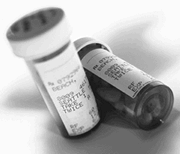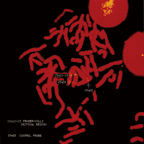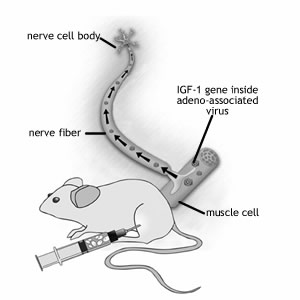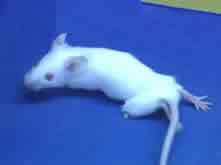















Jump to:
Drug Development | Drug Trials | Markers & Finding New Genes | Gene Therapy | Stem Cells | Mice Models
Much research is being done in finding the causes of ALS, ways to detect the disease in its earliest stages, tracking it during progression, and finding successful treatments. New drugs are being tested, while mice models allow researchers to track symptoms and experiment new treatments. Gene therapy and stem cell research seems promising in treatment, but much more study is needed before an effective treatment can be developed.
 Various drugs are being tested in hopes of finding one that could produce a stronger effect than Rilutek�, which only extends life for an average of three months. The hundreds of drugs tested every year could have the potential to slow or halt disease progression, but these have to go through multiple screening phases before the final ones that are found most beneficial are approved for treatment by the FDA. Drug research for ALS involves testing drugs that prevent apoptosis, excitotoxicity, oxidative stress, and others. A combination of different drugs, called a drug cocktail, may be needed in providing successful treatment.
Various drugs are being tested in hopes of finding one that could produce a stronger effect than Rilutek�, which only extends life for an average of three months. The hundreds of drugs tested every year could have the potential to slow or halt disease progression, but these have to go through multiple screening phases before the final ones that are found most beneficial are approved for treatment by the FDA. Drug research for ALS involves testing drugs that prevent apoptosis, excitotoxicity, oxidative stress, and others. A combination of different drugs, called a drug cocktail, may be needed in providing successful treatment.
 In drug trials, a number of patients will be given a test drug and their progress will be monitored. These are used to determine which drugs have the highest effects and potential of becoming a candidate for treatment. There are many different types of trials, such as placebo-based trials. Half of the patients get the test drug, while the other half receive a pill with nothing much more than sugar. The ones getting the placebo are the control group. Whether the drug works is compared to those patients on the placebo, yet no one but the doctors know who is getting what. Crossover trials are ones where those receiving placebo and those with the drug switch, so if there is benefit, everyone is getting it. Double-blind trials are ones where no one knows who is getting what, allowing doctors to only concentrate on assessing one's improvements.
In drug trials, a number of patients will be given a test drug and their progress will be monitored. These are used to determine which drugs have the highest effects and potential of becoming a candidate for treatment. There are many different types of trials, such as placebo-based trials. Half of the patients get the test drug, while the other half receive a pill with nothing much more than sugar. The ones getting the placebo are the control group. Whether the drug works is compared to those patients on the placebo, yet no one but the doctors know who is getting what. Crossover trials are ones where those receiving placebo and those with the drug switch, so if there is benefit, everyone is getting it. Double-blind trials are ones where no one knows who is getting what, allowing doctors to only concentrate on assessing one's improvements.
 Markers are used to determine the presence of disease and also manage progression and the effects of treatment; there is currently no marker for ALS. Biological markers are used to find the genes that cause a disease and are present in patients who have the disease. In a person with a disease, certain genes may be cloned and have their DNA sequences (the letters ATCG) looked at. Special variations in the sequences are noted, and these are used as markers in locating the gene, since most genetic diseases have an underlying cause near biological markers. As genes are passed down in the family, markers are tracked. If a person gets the disease, then the presence of the marker may be checked and by establishing multiple markers, a gene may be found. The Human Genome Project, which is a mapping of the human genes, could aid in finding new genes that cause ALS.
Markers are used to determine the presence of disease and also manage progression and the effects of treatment; there is currently no marker for ALS. Biological markers are used to find the genes that cause a disease and are present in patients who have the disease. In a person with a disease, certain genes may be cloned and have their DNA sequences (the letters ATCG) looked at. Special variations in the sequences are noted, and these are used as markers in locating the gene, since most genetic diseases have an underlying cause near biological markers. As genes are passed down in the family, markers are tracked. If a person gets the disease, then the presence of the marker may be checked and by establishing multiple markers, a gene may be found. The Human Genome Project, which is a mapping of the human genes, could aid in finding new genes that cause ALS.
Gene therapy is a new treatment in which genetic diseases are treated by giving a person a healthy copy of their defective gene, instead of giving them a drug. The problem with gene therapy in ALS is that only some cases are genetically inherited, ways are needed to recreate the gene, and an effective delivery method needs to be found to get the gene into the body. Since there have only been two genes identified to cause ALS, researchers are also looking for mutations in genes that, along with an environmental trigger, cause the disease. For example, in studies using mice breed to develop ALS, researchers injected genes with neurotrophic factors into the mice and observed their effects. A research team at John Hopkins University inserted a gene that codes for the protein insulin-like growth factor (IGF-1) inside an adeno-associated virus. The transport vehicle (the virus) with the gene was injected into limb and respiratory muscles of mice. Researchers noticed that onset of disease was later than those who had not received the gene, the mice survived longer, had more muscle mass, and the gene produced levels of IGF-1 protein on neurons. Studies like these in mice can prove to be of benefit to humans.

 Stem cells are cells that can divide infinitely in culture and be turned into any type of mature cell. Researchers are looking to see if stem cells can help ALS patients by turning into motor neurons that would replace the ones destroyed. In some studies, stem cells have been found to be more beneficial in repairing neurons than replacing them. In others still, neurotrophic factors had been released from the stem cells, giving motor neurons growth and increased survival. There is much more that can hopefully be done in the future with continuing stem cell research.
Stem cells are cells that can divide infinitely in culture and be turned into any type of mature cell. Researchers are looking to see if stem cells can help ALS patients by turning into motor neurons that would replace the ones destroyed. In some studies, stem cells have been found to be more beneficial in repairing neurons than replacing them. In others still, neurotrophic factors had been released from the stem cells, giving motor neurons growth and increased survival. There is much more that can hopefully be done in the future with continuing stem cell research.
 Mice are bred with ALS or with mutations to their genes to represent humans and provide a useful way in testing out stem cell therapy, gene therapy, and new drugs. In other words, the mice are our test subjects. As an example of mice models, mice can be bred with a defective SOD1 gene that causes them to develop ALS later in their lives. Once with ALS, researchers can administer drugs to the mice and examine their effects, internally and externally, and compare their results with control mice, those without the treatment. Researchers can also breed mice with a defective or missing gene and examine the role the gene plays. For example, taking out the VEGF gene in mice can cause ALS, therefore suggesting the connection between the specific gene and ALS. Lastly, mice have been used for stem cell research, where researchers are seeing if the stem cells would grow into new motor neurons. The effect of stem cell research is mainly tested in mice to predict the likelihood of effectiveness in humans.
Mice are bred with ALS or with mutations to their genes to represent humans and provide a useful way in testing out stem cell therapy, gene therapy, and new drugs. In other words, the mice are our test subjects. As an example of mice models, mice can be bred with a defective SOD1 gene that causes them to develop ALS later in their lives. Once with ALS, researchers can administer drugs to the mice and examine their effects, internally and externally, and compare their results with control mice, those without the treatment. Researchers can also breed mice with a defective or missing gene and examine the role the gene plays. For example, taking out the VEGF gene in mice can cause ALS, therefore suggesting the connection between the specific gene and ALS. Lastly, mice have been used for stem cell research, where researchers are seeing if the stem cells would grow into new motor neurons. The effect of stem cell research is mainly tested in mice to predict the likelihood of effectiveness in humans.